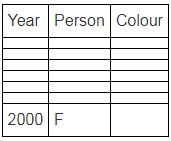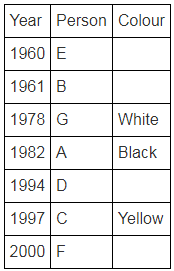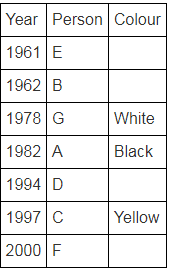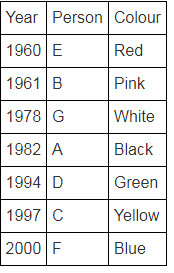CAT Exam > CAT Questions > Directions: Seven people A, B, C, D, E, F an...
Start Learning for Free
Directions: Seven people A, B, C, D, E, F and G are born in different years and like different colours - red, blue, pink, yellow, green, black and white not necessarily in same order.
B and E are born in consecutive years (B being younger), one of them been born in 1961.
The one who likes black is born in 1982 and is 4 years younger than the one who likes white.
The difference between present ages of A and D is 10 less than the difference between present ages of G and F. (A and G are elder than D and F respectively)
G is born in 1978.
F is born in 2000 and is youngest and doesn't like pink.
C likes yellow and is born three years after D was born, who is 6 years elder than F and 34 years younger to one who likes red colour.
The second eldest person doesn't like green.
The no. of people elder than the one who likes pink are 1 more than the no. of people younger than one who likes blue.
Who is the eldest person?
- a)B
- b)E
- c)A
- d)D
- e)C
Correct answer is option 'B'. Can you explain this answer?
| FREE This question is part of | Download PDF Attempt this Test |
Verified Answer
Directions: Seven people A, B, C, D, E, F and G are born in different...
F is born in 2000
Since, F is youngest, so, no one is born after F.
G is born in 1978
D is 6 years elder than F
So,
D is born in 1994
C is born 3 years after D
C is born in 1997
So, difference in ages of G and F = 22 years
Thus, Difference in ages of A and D = 22 - 10 = 12 years
So, A is born in 1982

The one who likes black is born in 1982
White is liked by the one who is 4 years elder than who is born in 1982
So, person who likes white - born in 1978
Hence, G likes white as G is born in 1978
We get,
G - 1978 - white
A - 1982 - black
D - 1994
C - 1997 - yellow
We are left with years of birth of B and E.
CASE I:
If, B is born in 1961, then E must be born in 1960

CASE II:
And, B is born in 1962, then E must be born in 1961

Now,
D is 34 years younger to one who likes red colour
So, one who likes red colour is born in year = 1994 - 34 = 1960
Thus, case II becomes invalid
We get,

Second eldest is B who doesn't like green
F doesn't like pink
So,

The no. of people elder than the one who likes pink are 1 more than the no. of people younger than one who likes blue.
So,
Case 1:
If B is pink then, 1 person is elder than B
Then, 0 person should be younger than who likes blue, so F must like blue.
And, D must like green
Case 2:
If D likes pink, no of person elder than D = 4
No of person younger than one who likes blue = 3 which is not possible
So, this case is invalid
The final arrangement is,

E is the eldest.

|
Explore Courses for CAT exam
|

|
Similar CAT Doubts
Directions: Seven people A, B, C, D, E, F and G are born in different years and like different colours - red, blue, pink, yellow, green, black and white not necessarily in same order. B and E are born in consecutive years (B being younger), one of them been born in 1961. The one who likes black is born in 1982 and is 4 years younger than the one who likes white. The difference between present ages of A and D is 10 less than the difference between present ages of G and F. (A and G are elder than D and F respectively) G is born in 1978. F is born in 2000 and is youngest and doesn't like pink. C likes yellow and is born three years after D was born, who is 6 years elder than F and 34 years younger to one who likes red colour. The second eldest person doesn't like green. The no. of people elder than the one who likes pink are 1 more than the no. of people younger than one who likes blue. Who is the eldest person?a)Bb)Ec)Ad)De)CCorrect answer is option 'B'. Can you explain this answer?
Question Description
Directions: Seven people A, B, C, D, E, F and G are born in different years and like different colours - red, blue, pink, yellow, green, black and white not necessarily in same order. B and E are born in consecutive years (B being younger), one of them been born in 1961. The one who likes black is born in 1982 and is 4 years younger than the one who likes white. The difference between present ages of A and D is 10 less than the difference between present ages of G and F. (A and G are elder than D and F respectively) G is born in 1978. F is born in 2000 and is youngest and doesn't like pink. C likes yellow and is born three years after D was born, who is 6 years elder than F and 34 years younger to one who likes red colour. The second eldest person doesn't like green. The no. of people elder than the one who likes pink are 1 more than the no. of people younger than one who likes blue. Who is the eldest person?a)Bb)Ec)Ad)De)CCorrect answer is option 'B'. Can you explain this answer? for CAT 2024 is part of CAT preparation. The Question and answers have been prepared according to the CAT exam syllabus. Information about Directions: Seven people A, B, C, D, E, F and G are born in different years and like different colours - red, blue, pink, yellow, green, black and white not necessarily in same order. B and E are born in consecutive years (B being younger), one of them been born in 1961. The one who likes black is born in 1982 and is 4 years younger than the one who likes white. The difference between present ages of A and D is 10 less than the difference between present ages of G and F. (A and G are elder than D and F respectively) G is born in 1978. F is born in 2000 and is youngest and doesn't like pink. C likes yellow and is born three years after D was born, who is 6 years elder than F and 34 years younger to one who likes red colour. The second eldest person doesn't like green. The no. of people elder than the one who likes pink are 1 more than the no. of people younger than one who likes blue. Who is the eldest person?a)Bb)Ec)Ad)De)CCorrect answer is option 'B'. Can you explain this answer? covers all topics & solutions for CAT 2024 Exam. Find important definitions, questions, meanings, examples, exercises and tests below for Directions: Seven people A, B, C, D, E, F and G are born in different years and like different colours - red, blue, pink, yellow, green, black and white not necessarily in same order. B and E are born in consecutive years (B being younger), one of them been born in 1961. The one who likes black is born in 1982 and is 4 years younger than the one who likes white. The difference between present ages of A and D is 10 less than the difference between present ages of G and F. (A and G are elder than D and F respectively) G is born in 1978. F is born in 2000 and is youngest and doesn't like pink. C likes yellow and is born three years after D was born, who is 6 years elder than F and 34 years younger to one who likes red colour. The second eldest person doesn't like green. The no. of people elder than the one who likes pink are 1 more than the no. of people younger than one who likes blue. Who is the eldest person?a)Bb)Ec)Ad)De)CCorrect answer is option 'B'. Can you explain this answer?.
Directions: Seven people A, B, C, D, E, F and G are born in different years and like different colours - red, blue, pink, yellow, green, black and white not necessarily in same order. B and E are born in consecutive years (B being younger), one of them been born in 1961. The one who likes black is born in 1982 and is 4 years younger than the one who likes white. The difference between present ages of A and D is 10 less than the difference between present ages of G and F. (A and G are elder than D and F respectively) G is born in 1978. F is born in 2000 and is youngest and doesn't like pink. C likes yellow and is born three years after D was born, who is 6 years elder than F and 34 years younger to one who likes red colour. The second eldest person doesn't like green. The no. of people elder than the one who likes pink are 1 more than the no. of people younger than one who likes blue. Who is the eldest person?a)Bb)Ec)Ad)De)CCorrect answer is option 'B'. Can you explain this answer? for CAT 2024 is part of CAT preparation. The Question and answers have been prepared according to the CAT exam syllabus. Information about Directions: Seven people A, B, C, D, E, F and G are born in different years and like different colours - red, blue, pink, yellow, green, black and white not necessarily in same order. B and E are born in consecutive years (B being younger), one of them been born in 1961. The one who likes black is born in 1982 and is 4 years younger than the one who likes white. The difference between present ages of A and D is 10 less than the difference between present ages of G and F. (A and G are elder than D and F respectively) G is born in 1978. F is born in 2000 and is youngest and doesn't like pink. C likes yellow and is born three years after D was born, who is 6 years elder than F and 34 years younger to one who likes red colour. The second eldest person doesn't like green. The no. of people elder than the one who likes pink are 1 more than the no. of people younger than one who likes blue. Who is the eldest person?a)Bb)Ec)Ad)De)CCorrect answer is option 'B'. Can you explain this answer? covers all topics & solutions for CAT 2024 Exam. Find important definitions, questions, meanings, examples, exercises and tests below for Directions: Seven people A, B, C, D, E, F and G are born in different years and like different colours - red, blue, pink, yellow, green, black and white not necessarily in same order. B and E are born in consecutive years (B being younger), one of them been born in 1961. The one who likes black is born in 1982 and is 4 years younger than the one who likes white. The difference between present ages of A and D is 10 less than the difference between present ages of G and F. (A and G are elder than D and F respectively) G is born in 1978. F is born in 2000 and is youngest and doesn't like pink. C likes yellow and is born three years after D was born, who is 6 years elder than F and 34 years younger to one who likes red colour. The second eldest person doesn't like green. The no. of people elder than the one who likes pink are 1 more than the no. of people younger than one who likes blue. Who is the eldest person?a)Bb)Ec)Ad)De)CCorrect answer is option 'B'. Can you explain this answer?.
Solutions for Directions: Seven people A, B, C, D, E, F and G are born in different years and like different colours - red, blue, pink, yellow, green, black and white not necessarily in same order. B and E are born in consecutive years (B being younger), one of them been born in 1961. The one who likes black is born in 1982 and is 4 years younger than the one who likes white. The difference between present ages of A and D is 10 less than the difference between present ages of G and F. (A and G are elder than D and F respectively) G is born in 1978. F is born in 2000 and is youngest and doesn't like pink. C likes yellow and is born three years after D was born, who is 6 years elder than F and 34 years younger to one who likes red colour. The second eldest person doesn't like green. The no. of people elder than the one who likes pink are 1 more than the no. of people younger than one who likes blue. Who is the eldest person?a)Bb)Ec)Ad)De)CCorrect answer is option 'B'. Can you explain this answer? in English & in Hindi are available as part of our courses for CAT.
Download more important topics, notes, lectures and mock test series for CAT Exam by signing up for free.
Here you can find the meaning of Directions: Seven people A, B, C, D, E, F and G are born in different years and like different colours - red, blue, pink, yellow, green, black and white not necessarily in same order. B and E are born in consecutive years (B being younger), one of them been born in 1961. The one who likes black is born in 1982 and is 4 years younger than the one who likes white. The difference between present ages of A and D is 10 less than the difference between present ages of G and F. (A and G are elder than D and F respectively) G is born in 1978. F is born in 2000 and is youngest and doesn't like pink. C likes yellow and is born three years after D was born, who is 6 years elder than F and 34 years younger to one who likes red colour. The second eldest person doesn't like green. The no. of people elder than the one who likes pink are 1 more than the no. of people younger than one who likes blue. Who is the eldest person?a)Bb)Ec)Ad)De)CCorrect answer is option 'B'. Can you explain this answer? defined & explained in the simplest way possible. Besides giving the explanation of
Directions: Seven people A, B, C, D, E, F and G are born in different years and like different colours - red, blue, pink, yellow, green, black and white not necessarily in same order. B and E are born in consecutive years (B being younger), one of them been born in 1961. The one who likes black is born in 1982 and is 4 years younger than the one who likes white. The difference between present ages of A and D is 10 less than the difference between present ages of G and F. (A and G are elder than D and F respectively) G is born in 1978. F is born in 2000 and is youngest and doesn't like pink. C likes yellow and is born three years after D was born, who is 6 years elder than F and 34 years younger to one who likes red colour. The second eldest person doesn't like green. The no. of people elder than the one who likes pink are 1 more than the no. of people younger than one who likes blue. Who is the eldest person?a)Bb)Ec)Ad)De)CCorrect answer is option 'B'. Can you explain this answer?, a detailed solution for Directions: Seven people A, B, C, D, E, F and G are born in different years and like different colours - red, blue, pink, yellow, green, black and white not necessarily in same order. B and E are born in consecutive years (B being younger), one of them been born in 1961. The one who likes black is born in 1982 and is 4 years younger than the one who likes white. The difference between present ages of A and D is 10 less than the difference between present ages of G and F. (A and G are elder than D and F respectively) G is born in 1978. F is born in 2000 and is youngest and doesn't like pink. C likes yellow and is born three years after D was born, who is 6 years elder than F and 34 years younger to one who likes red colour. The second eldest person doesn't like green. The no. of people elder than the one who likes pink are 1 more than the no. of people younger than one who likes blue. Who is the eldest person?a)Bb)Ec)Ad)De)CCorrect answer is option 'B'. Can you explain this answer? has been provided alongside types of Directions: Seven people A, B, C, D, E, F and G are born in different years and like different colours - red, blue, pink, yellow, green, black and white not necessarily in same order. B and E are born in consecutive years (B being younger), one of them been born in 1961. The one who likes black is born in 1982 and is 4 years younger than the one who likes white. The difference between present ages of A and D is 10 less than the difference between present ages of G and F. (A and G are elder than D and F respectively) G is born in 1978. F is born in 2000 and is youngest and doesn't like pink. C likes yellow and is born three years after D was born, who is 6 years elder than F and 34 years younger to one who likes red colour. The second eldest person doesn't like green. The no. of people elder than the one who likes pink are 1 more than the no. of people younger than one who likes blue. Who is the eldest person?a)Bb)Ec)Ad)De)CCorrect answer is option 'B'. Can you explain this answer? theory, EduRev gives you an
ample number of questions to practice Directions: Seven people A, B, C, D, E, F and G are born in different years and like different colours - red, blue, pink, yellow, green, black and white not necessarily in same order. B and E are born in consecutive years (B being younger), one of them been born in 1961. The one who likes black is born in 1982 and is 4 years younger than the one who likes white. The difference between present ages of A and D is 10 less than the difference between present ages of G and F. (A and G are elder than D and F respectively) G is born in 1978. F is born in 2000 and is youngest and doesn't like pink. C likes yellow and is born three years after D was born, who is 6 years elder than F and 34 years younger to one who likes red colour. The second eldest person doesn't like green. The no. of people elder than the one who likes pink are 1 more than the no. of people younger than one who likes blue. Who is the eldest person?a)Bb)Ec)Ad)De)CCorrect answer is option 'B'. Can you explain this answer? tests, examples and also practice CAT tests.

|
Explore Courses for CAT exam
|

|
Suggested Free Tests
Signup for Free!
Signup to see your scores go up within 7 days! Learn & Practice with 1000+ FREE Notes, Videos & Tests.























